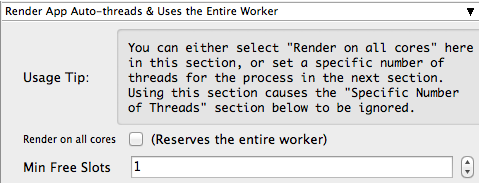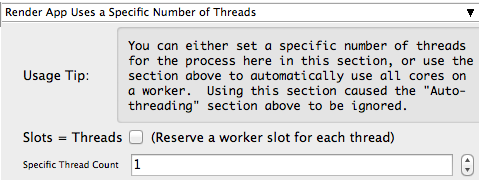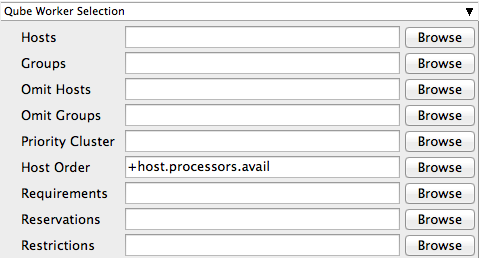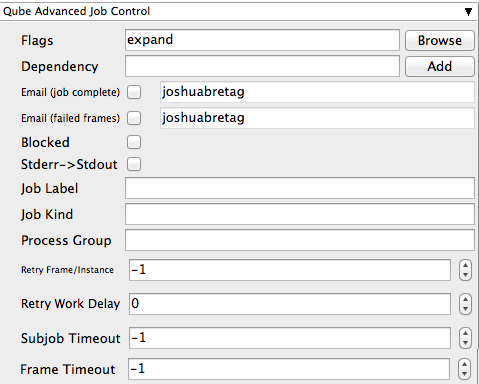-

- Created by Unknown User (joshua), last modified on Aug 15, 2013
You are viewing an old version of this page. View the current version.
Compare with Current View Page History
« Previous Version 3 Next »
Below Is an expandable view of the "Maxwell Render Job..." Jobtype Submission UI
Please click on the section of interest

Name
Tooltip - Name of the job
This is the name of the job of the job so it can be easily identified in the Qube! UI
Priority
Tooltip - Numeric priority (
Every job in Qube is assigned a numeric priority. Priority 1 is higher than priority 100. This is similar to 1st place, 2nd place, 3rd place, etc. The default priority assigned to a job is 9999.
Instances
Tooltip -
Instances are the amount of times you would like to spawn a session of your application
Example:
On a 12 slot(core) machine running Maya if you set
"Instances" to 4
"Reservations" to "host.processors=3"
Qube! will open 4 sessions of Maya on the worker simultaneously consuming all slots/cores
if you set
"Instances" to 1
"Reservations" to "host.processors=1+"
Qube will open 1 session of Maya on the worker consuming all slots/cores ("host.processors=1+" is used for all slots/cores)
more on Instances & Reservations

Range
Tooltip - Frame range for the job (e.g 1-100, or 1-100x3, or 1,3,7,10)
Most jobs require a frame range in which to execute on the worker's you can set this range in a few different ways :
"1-100" will just render the range between 1 and 100
"1-100x3" will render the range 1 to 100 in chunks of 3
"1,3,7,10" will only render the selected frames 1,3,7,10
Execution
Tooltip - How to break up frame range to be executed. Use QB_START_FRAME, QB_END_FRAME and QB_FRAME_NUMBER
When submitting a job to the farm it may be more efficient to "chunk" your job. This means that when the job is sent to the worker it tells the worker to render X consecutive frames before requesting more work.
The drop down options are below:
"Individual frames" this tells the worker to render 1 frame at a time
"Chunks with n frames" this tells the worker to render consecutively the number of frames specified in the parallel spinner
"Split into n partitions" this tells the worker to render consecutively the total frames in the range divided by the number in the parallel spinner
Examples:
range 1-100 with "individual frames" set will render 1 frame at a time
range 1-100 with "Chunks with n frames" and the spinner set to 10 will send 10 frames to each worker
range 1-100 with "Split into n partitions" and the spinner set to 4 will send 25 frames to each worker
rangeOrdering
Tooltip - Order to render the items. (Ascending=1,2,3,4,5...,Descending=10,9,8...,Binary=first,middle,last...)
You can set the order in which your frames are rendered. The drop down options are:
"Ascending" this will render the frames counting upwards from your start frame
"Decending" this will render the frames counting backwards from your end frame
"Binary" Explanation needed

Use Preview Frames
Tooltip - Submit high-priority preview frames for this job
Enabling preview frames will create 2 jobs:
A primary dependent job with a higher priority that will render the selected frames first
and a secondary job with lower priority that will render the remaining frames
This will return the selected frames faster so that you can troubleshoot your renders
Frame Numbers
Tooltip - Preview frames list for the job. Leave blank to use default (1st, last, middle) frames (e.g 1,2,10)
Choose the frames that you wish to render first.
If left blank "Default" is selected which renders the first frame , the last frame and the middle frame in that order.
You can select the frames by adding comma separated frame numbers e.g 1,2,10,15,75
Preview Priority
Tooltip - Preview Frame Priority
Choose the priority for the primary job.
Preview Subjobs
Tooltip - Number of subjobs to use for the preview frames
Choose the instances/subjobs for the primary job.

New in 6.4-4
For applications that do not support setting the number of threads, this section is not visible.
Render on all cores
Tooltip -
placeholder
Min Free Slots
Tooltip -
placeholder

Slots = Threads
Tooltip -
placeholder
Specific Thread Count
Tooltip -
placeholder

maxwell path
Tooltip - explicit path to Maxwell v2 executable.
browse or enter manually the location of Maxwell.exe on the workers

Enable coOp Renders
Tooltip - Perform a cooperative render. Make sure you set the "Instances" parameter to more than 1, in the "Qube Job Basics" section above
Setting this to co-op will create a secondary MXIMerge job that combines the finished MXI's upon completion
Coop Total SL
Tooltip - (Cooperative Rendering only) - Final quality level for the coop render, when the MXIs are all merged. Set to 0 for all instances to respect the value set in the "Sampling Level" box below'
If Co-op rendering is selected you can choose the Sampling level for the final render
Sampling Level
Tooltip - Quality level for the render, overrides Sampling value saved in MXS.
Provide a numeric value for the Sampling override
Render Time Limit
Tooltip - Time (in minutes) that the renderer is allowed to run (per-frame), overrides Time value saved in MXS.
Provide a numeric value for time in minutes that the render is allowed to commense
Resume Rendering
Tooltip - automatically resume the render if the MXI file exists
Tick box to resume render when previous MXI files exist

MXS scene file
Tooltip - MXS scene to render
Browse or enter manually the location of the scene file to be rendered. This is a required field for submission
Important: Best practise is to ensure the scene file and all of its dependant files such as textures are on network storage accessible by the workers.
outputImage
Tooltip - full path and name of the image file.
Browse or manually enter the location of the output image file you wish to generate
Important: Best practise is to ensure outputs are written to network storage accessible by the workers
MXI output file
Tooltip - MXI output file containing information about the rendering process. It allows for resuming previously rendered image. If not specified, the MSI will use the same name and path as the MXS scene
Browse or manually enter the location of the output MXI file you wish to generate
Important: Best practise is to ensure outputs are written to network storage accessible by the workers
script
Tooltip - Load and run a given script
Browse or manually enter the required scripts
Important: Best Practise is to ensure scripts are on network storage accessible by the workers
prescript
Tooltip - Load and run a given script
Browse or manually enter the required prescripts
Important: Best Practise is to ensure scripts are on network storage accessible by the workers
postscript
Tooltip - Load and run a given script
Browse or manually enter the required postscripts
Important: Best Practise is to ensure scripts are on network storage accessible by the workers
bitmaps
Tooltip - Set an alternative folder path for the bitmaps location. If "0", then will discard all the bitmaps
Browse or manually enter the location of the bitmaps file you wish to generate
Important: Best practise is to ensure bitmaps are written to network storage accessible by the workers
overridemat
Tooltip - Override all materials in the scen using the material indicated in the path
Browse or manually enter the location of the textures you wish to replace
Important: Best practise is to ensure textures are written to network storage accessible by the workers
curdir
Tooltip - Set the current directory of the OS. This could be useful for using relative paths for textures and other dependencies.
Browse or manually enter the location of the current directory
dependencies
Tooltip - Set an alternative folder path for the dependencies location.
Browse or manually enter the location of the required dependancies
resume
Tooltip - Continue a render from a previously saved MXI file. To resume a previously rendered images and update the MXI file, this flag must be added.
Browse or manually enter the location of the MXI file to be resumed
renameoutput
Tooltip - When this flag is used, Maxwell Render does not write the MXI file directly in the given output path; it write a temporary file and when the writing process finishes it renames it to the final path.
Tick box to rename MXI file upon completion

res
Tooltip - resolution override (WxH)
Used for overriding the scenes resolution. IE: 800x600
region
Tooltip - type,x1,y1,x2,y2 : Specify if you want to render the full frame, a region, or blowup a region, specifying also the corrdinates of the rectangular marquee. Type is "full", "region", or "blowup".
Used for specifying a specific region or section of the frame to render or enlarge.
depth
Tooltip - image depth
Used to override scenes current image depth settings.
channels
Tooltip - specify channels layers that Maxwell will export (r,a,ao,s,m,i,z<min/max>)
Click choices to override the export of channels layers.
channel
Tooltip - [channel_name],[on|off],[depth(8,16,32)],[format] : Different channels that can export and their format. All the parameters are optional except for the first one. Examples: channel:alpha,on,32,tif... channel:material... channel:object,off
Used to override different channels that can export and their format. see tooltip for examples.
zmin
Tooltip - zmin value of the zbuffer channel
Used to override the zmin values
zmax
Tooltip - zmax value of the zbuffer channel
Used to override the zmax values
alphaopaque
Tooltip - Enable the opaque mode in alpha channel
Tick box to enable
alphaembedded
Tooltip - Enable alpha embed
Tick box to enable
embedded
Tooltip - Embeds the selected channel when the output format allows it
Tick box to enable
channelsembedded
Tooltip - Enable/disable embedding all the channels as images layers if the format supports it
Tick box to enable
color
Tooltip - set a color space
Click choices to override the color space required
camera
Tooltip - camera to render (otherwise defauls to active camera)
Used to override the chosen camera if multiple are available
defaultmat
Tooltip - Indicate the path to the default material
Used to override the path to the default materials
Important: Best practise is to ensure materials are on network storage accessible by the workers
burn
Tooltip - set the burn value
Enter a number to override the burn value
gamma
Tooltip - Set the gamma value
Enter a number to override the gamma value

pass
Tooltip - Set the render pass
Chose the pass from the drop down box to override scene defaults
multilight
Tooltip - Enable multilight function storing an MSI file with separate information about the emitters
Chose the required setting from the drop down box to override scene defaults
extractlights
Tooltip - Save each light in a separate file if Multilight is enabled
placeholder
devignetting
Tooltip - devignetting value
placeholder
scattering
Tooltip - scattering value
placeholder
displacement
Tooltip - Enable/disable the displacement calculations for the whole scene
placeholder
dispersion
Tooltip - Enable/disable the dispersion calculations for the whole scene
placeholder
motionblur
Tooltip - Enable/disable the motion blur calculations for the whole scene
placeholder
dodevignetting
Tooltip -
placeholder
doscattering
Tooltip - Enable the lens scattering for the renderer
placeholder

verbose
Tooltip - Verbosity level
Choose from the level of detail you would like the logs to provide
threads
Tooltip - number of threads to render with (0 means use maximum number)
Enter a numeric value for the amount of threads to be spawned on the workers while processing this job
priority
Tooltip - Maxwell Renderer process priority
Choose the required CPU priority for the job on the worker
slupdate
Tooltip - [seconds] Force the engine to refresh the sampling level info at the given ratio instead of doing it automatically.
Enter a numeric value in seconds for refresh of sampling info
mintime
Tooltip - Set the time to impose a minimum time for saving MXI files to disk, like the new preference "Min.Time"
Enter a numeric value in minutes for automatic saving of MXI files to disk
nomxi
Tooltip - Force Macwell Render not to save an MXI file but just the output image
Tick Box to frce Maxwell not to create MXI files while rendering

Internal(Range)
Tooltip -
placeholder

Cmd Template
Tooltip -
placeholder
Shell (Linux/OSX)
Tooltip -
placeholder


Hosts
Tooltip - Explicit list of Worker hostnames to run the job on (comma-separated)
Click browse to choose from a list of workers that you want to run the job on
Groups
Tooltip - Explicit list of Worker groups to run the job on (comma-separated)
Click browse to choose from a list of groups that you want to run the job on
Omit Hosts
Tooltip - Explicit list of Worker hostnames to NOT run the job on (comma-separated)
Click browse to choose from a list of workers that you do NOT want to run the job on
Omit Groups
Tooltip - Explicit list of Worker groups to NOT run the job on (comma-separated)
Click browse to choose from a list of groups that you NOT want to run the job on
Priority Cluster
Tooltip - Worker cluster that the job has elevated priority to run on
Click browse to choose from a list of Priority Clusters
 | Clusters are a way of distributing jobs across the farm with the ability to expand and shrink based on the submitted priority cluster Example:
|
|---|
Host Order
Tooltip - Order to select Workers for running the job (comma-separated) [+ means ascending, - means descending]
Click browse to choose from a list of Host Order Options
 | Host Order is a way of telling the job how to select/order workers
|
|---|
Requirements
Tooltip - Worker requirements needed to be met for job to run on that Worker (comma-separated, expression-based)
Click browse to choose from a list of Host Order Options
 | Requirements is a way to tell the workers that this job needs specific requirements to be met in order to run drop-down menu items:
The above is not the limit of what "Requirements" can do see a list below of other alterable variants:
|
|---|
Reservations
Tooltip - Worker resources to reserve when running job (comma-separated, expression-based)
Click browse to choose from a list of Reservation Options
 | Reservations is a way to tell the workers that this job will reserve the specific resources for this job Menu items:
The above is not the limit of what "Reservations" can do see a list below of other alterable variants:
|
|---|
Restrictions
Tooltip - Restrict job to run only on specified clusters ("||"-separated) [+ means all below, * means at that level]
Click browse to choose from a list of Restrictions Options
 | Restrictions is a way to tell the workers that this job can only run on specific clusters Example:
|
|---|
See Also

Flags
Tooltip - List of submission flag strings (comma separated)
| Click browse to choose required job flags
|
|---|
Dependency
Tooltip - Wait for specified jobs to complete before starting this job (comma-separated)
 | Click Add to create dependant jobs you can link jobs states to each other by several factors "complete" means only start this job after designated job completes "failed" means only start this job if the designated job fails "killed" means only start this job if the job has been killed "done" means start this job if the job is killed/failed/complete |
|---|
Email (job complete)
Tooltip - Send email on job completion (success or failure)
Sends mail to the designated user based on the status of the job being complete
Email (failed frames)
Tooltip - Send email on job completion (success or failure)
Sends mail to the designated user based on the status of the job being failed
Blocked
Tooltip - Set initial state of job to "blocked"
Enable this tickbox to ensure after submission this job is in a blocked state
Stderr->Stdout
Tooltip - Redirect and consolidate the job stderr stream to the stdout stream
Enable this if you would like to combine you logs
Job Label
Tooltip - Optional label to identify the job. Must be a unique within a Job Process Group (pgrp).
Legacy method of labelling jobs see Job Tags
Job Kind
Tooltip - Arbitrary typing information that can be used to identify the job. Common usage: it can be used to restrict only 1 of this "kind" of job from running on a worker at the same time by setting the job\'s requirements to include "not (job.kind in host.duty.kind)"
Process Group
Tooltip - Job Process Group (pgrp) for logically organizing dependent jobs. Defaults to the jobid. Combination of "label" and "Process Group" (pgrp) must be unique for a job.
Retry Frame/Instance
Tooltip - Number of times to retry a failed frame/job instance. Value of -1 means use the default for the studio.
Set this to retry any failed frames or instances automatically
Retry Work Delay
Tooltip - Number of seconds to wait before automatically retrying a failed frame/work.
Set this to create a delay in second between the frame/instance retries
Subjob Timeout
Tooltip - Kill the subjob process if running for the specified time (in seconds). Value of -1 means disabled.
Use this if the acceptable instance/subjob spawn time is known.
Frame Timeout
Tooltip - Kill the agenda/frame if running for the specified time (in seconds). Value of -1 means disabled.
Use this if the acceptable frame time is known.

Cwd
Tooltip - Current Working Directory to use when running the job
Explanation needed
Environment Variables
Tooltip - Environment variables override when running a job
You can specify key/value pairs of environment variables
This is useful when you might need different settings for your render applications based on different departments or projects
Impersonate User
Tooltip - Submit a job as a specific user. Default is current user. Format <optionladomain>\<username> (advanced --requires impersonate user permissions)
You can specify which user you would like to submit the job as
This is useful for troubleshooting a job that may fail sent from a specific user
Example:
Setting "qube\josh" would attempt to submit the job with the domain "qube" and the user "josh"
Note: "impersonate user" permissions need to be set on the user submitting this job

Windows-only Environment Variables
Tooltip - Windows Environment variable overrides when running job
Used to provide OS specific environment variables for Windows
Linux-only Environment Variables
Tooltip - Linux Environment variable overrides when running job
Used to provide OS specific environment variables for Linux
Darwin-only Environment Variables
Tooltip - OSX Environment variable overrides when running job
Used to provide OS specific environment variables for OSX


GenerateMovie
Tooltip - Add linked job to generate movie from output images
Select this option to create a secondary job that will wait for the render to complete then combine the output files into a movie
Note: For this to work correctly the "Qube (ImagesToMovie) Job..." has to be setup to use your studios transcoding application

Account
Tooltip - Arbitrary accounting or project data (user-specified)
This can be used for creating tags for your job
The created tags can be searched in the "Performance Charts" Tab
You can add entries by typing in the drop-down window or select already created accounts from the drop-down
See also "Qube Job Tags"
Notes
Tooltip - Freeform text for making notes on this job
Add text about the job for future reference. Viewable in the Qube UI
